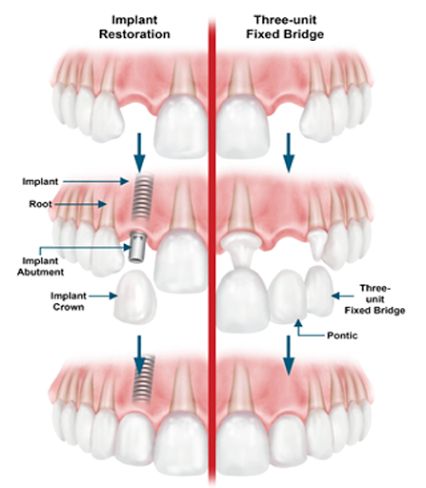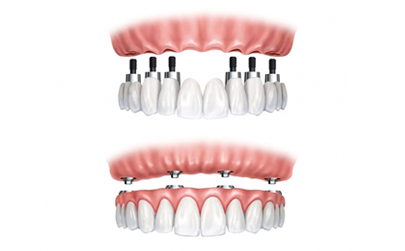+91-079-26421798
,+91 9825598120
For Appointment
A dental implant is an innovative solution to replace one or more missing teeth. Essentially, it acts as an artificial tooth root, surgically placed into the jawbone to support crowns, bridges, or dentures. If you're considering a Dental Implant in Ahmedabad, this comprehensive guide will help you understand the process and benefits, and how to find the Best Dental Implant services tailored to your needs.

Dental implants are versatile and can address various dental issues, including:
Single Tooth Replacement: Ideal for patients missing one tooth.
Multiple Tooth Replacement: Bridges supported by implants to replace several teeth.
Complete Arch Replacement: Restore all teeth in the upper or lower jaw using advanced methods like All-on-4® or All-on-6®.
Support for Removable Dentures: Implants provide a stable base, improving the functionality of removable dentures.
Patients searching for Dental Implants in Ahmedabad will find world-class facilities and expert dentists to ensure high success rates.
Most healthy individuals with good oral hygiene can undergo implant procedures. Dentists in Ahmedabad, including in areas like Navrangpura, assess several factors to determine suitability:
A clinical examination, including 3D imaging and x-rays, ensures a thorough assessment before proceeding. For those asking, “Is there a Dental Implant near me?” Ahmedabad offers numerous clinics equipped with cutting-edge diagnostic tools.
The implant placement involves the following steps:
If you’re deciding between options at a Dental Clinic in Ahmedabad, here are the benefits of dental implants:
Dental clinics in Ahmedabad leverage advanced techniques to ensure superior outcomes, including:
For patients seeking the Best Dental Implant options in Navrangpura, these technologies offer life-changing solutions.
Implants Functionality, it feels very much like natural teeth. For patients that have lived with removable appliances, you will feel much more secure with implant retained teeth versus your old removable teeth.
Most recent implant systems have a success rate of 90-98% for 10 years
Smoking significantly increases the risk of implant failure by impairing bone healing and osseointegration. Patients are advised to quit smoking before and after the procedure for the best outcomes.
Now a day's, an implant can be replaced if it fails to bond with the bone provided that adequate bone and gum tissue is present. Failures do not occur very often but they do occur.
Now a day's, existing dentures and other temporary appliances can be worn immediately after implant surgery. There are exceptions but our goal is to minimize any esthetic concerns during the healing phase
Now a day's, implants can be placed using local anesthesia in our office. In more complex cases, we may recommend that the surgical phase be performed while you are under sedation.
Sometimes if the quality and quantity of bone are adequate then immediate loading of implants can be possible where the final crown is given within 3-7 days.
Before beginning work on your jaw, Dr. Sheth uses a 3D CT Scan to capture an image of your jaw structure. With this data, sophisticated software creates a digital model of the shape of your mouth.


The All-on-4® treatment concept is a cost-efficient, graft less solution that provides patients with a fixed full-arch prosthesis on the day of surgery.
Full-arch rehabilitation with only four implants
Two straight anterior implants
and two implants tilted up to 45º in the posterior
Immediate Function (fixed provisional bridge)
For patients meeting criteria for
immediate loading of implants
Graft less procedure
Bone grafting is avoided by tilting the posterior implants,
utilizing available bone
The All-On-6® Dental Implant procedure creates a permanent prosthesis by using six dental implants. It acts as anchors for a bridge or over-denture. Six implants are positioned in the lower or upper jawbone to anchor prosthetic teeth in place permanently. After conducting a comprehensive examination using digital x-rays and a 3D Cone Beam CT-Scan, a dentist will evaluate the anatomical structures in the mouth. The dentist will then assess bone loss and create impressions to generate a new smile for you! Over time, the implants positioned in the jaw will fuse with the jawbone, representing the natural roots and giving back a natural smile.

Quick recovery
Enjoy eating and speaking again
Pearly white smile
No need for removable dentures
Instantly reverses age
You can bite and chew foods, just like natural teeth
Lifelong solution Dental implants are usually a permanent solution to missing teeth.
Bone grafting is rarely required
Easy home maintenance and cleaning
Delivers long-term results
Completely restored smile
Improves oral health
The simple procedure is low-cost and effective, making it an ideal choice. However, some may ask why they should choose All-on-6 as opposed to All-on-4? Neither of these options is necessarily better; it is a decision that should be made on a case-by-case basis. For example, if a more extensive reconstruction is needed, All-on-6 implants are a better choice because the additional implants provide additional support. However, if you do not have the additional bone mass required for the additional implants, you would be a more likely candidate for All-on-4.
The cost of a Dental Implant in Ahmedabad depends on factors such as the type of implant, the clinic, and any additional procedures required. Consult with a Dentist in Ahmedabad for a detailed quote.
The process varies based on individual needs:
Standard cases: 3–6 months (including healing time).
Immediate implants: Final restoration within 3–7 days if bone quality permits.
Yes, dental implants are designed to be a lifelong solution. Proper care, such as maintaining oral hygiene and regular dental check-ups, ensures their longevity.
All-on-4® uses four implants to support a full arch, avoiding the need for bone grafts.
All-on-6® offers extra stability with six implants, ideal for patients needing extensive restoration.
For those searching for the Best Dental Implant services or a Dental Clinic in Ahmedabad, areas like Navrangpura have reputed dentists offering advanced procedures with high success rates.
While smoking increases the risk of implant failure, patients willing to quit during the healing phase may still be eligible. Speak to a Dentist in Ahmedabad to evaluate your case.
Not always. Advanced techniques like All-on-4® and All-on-6® minimize the need for grafting by utilizing existing bone.
The procedure is performed under local anesthesia, ensuring minimal discomfort. Post-surgery, mild soreness can be managed with prescribed medication.
If you’re ready to explore your options for a Dental Implant in Ahmedabad, trust experienced dentists and advanced technology for a seamless experience. Whether you’re in Navrangpura or elsewhere in Ahmedabad, the journey to a confident, natural-looking smile starts with a consultation. Contact your nearest Dental Clinic in Ahmedabad today!